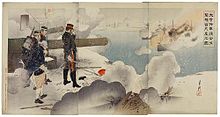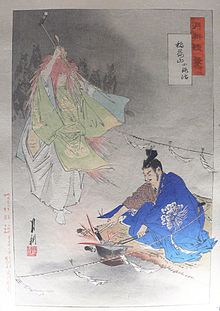- Ogata Gekkō
-
Ogata Gekkō (尾形月耕, 1859-1920) was a Japanese painter and woodblock print artist of the ukiyo-e genre.
Gekkō's work was originally closely based upon that of Kikuchi Yōsai; an he was inspired by Hokusai, creating a series of one hundred prints of Mount Fuji.[1] However, he did develop his own style, with significant stylistic elements from nihonga.
Contents
Career
 An incident in the Battle of Weihaiwei during the First Sino-Japanese War. Major General Ōdera at the cliff, 1895 — Woodblock print by Ogata Gekkō, ink and color on paper triptych; 37.9 x 72.8 cm (14 15/16 x 28 11/16 in.) in the collection of the Museum of Fine Arts, Boston.
An incident in the Battle of Weihaiwei during the First Sino-Japanese War. Major General Ōdera at the cliff, 1895 — Woodblock print by Ogata Gekkō, ink and color on paper triptych; 37.9 x 72.8 cm (14 15/16 x 28 11/16 in.) in the collection of the Museum of Fine Arts, Boston.
Gekkō's works were exhibited at a number of exhibitions, both those held domestically by the Ministry of Education and internationally.
Gekko's artwork was presented at the Chicago in 1893, at the Paris in 1900, and at the London in 1910.[1]
War artist
Gekkō was among the artists whose artwork informed the Japanese populace about the progress of naval and land war known today as the First Sino-Japanese War of 1894-1895.[2] A number of Gekko's war images were published in Seishin Bidan by Yokoyama Ryohachi.
An impression of the Haiyang Island (Kaiyoto) Naval Battle in 1894 was prepared in a large-scale quadruptich format.
Among the widely circulated Sino-Japanese tryptich images of the war which were created by Gekkō include:
- Japanese Officers and Soldiers Fight Bravely at Fenghuangcheng[3]
- The Japanese First Army Advances Toward Mukden[3]
- The Japanese Navy Victorious Off Takushan[3]
- Captain Osawa and Six Others From the Warship Yaeyama Close in on Yungcheng Bay[3]
- Presenting a Portentous Eagle to the Emperor[3]
- Popular Viewing of the Captured Chinese Warship Chenyuen[3]
- Japanese and Chinese Dignitaries Accomplish Their Missions in Successfully Concluding a Peace Treaty[3]
Selected works
Ogata Gekkō's published work is encompassed 46 works in 48 publications in 2 languages and 68 library holdings.[4]
- 1905 — 夢の三郎 (Yume no Saburō) OCLC 229891974
- 1898 — 月耕画園 (Gekko gaen) OCLC 225836025
- 1895 — 以呂波引月耕漫画 (Irohabiki Gekkō manga) OCLC 046354614
- 1885 — 新說小簾の月 (Shinsetsu osu no tsuki) OCLC 033798610
See also
Notes
 The swordsmith Munechika being aided by a kitsune fox spirit, in a print by Gekkō.
The swordsmith Munechika being aided by a kitsune fox spirit, in a print by Gekkō.
- ^ a b Nussbaum, Louis Frédéric et al. (2005). "Ogata Gekkō" in Japan Encyclopedia, p. 737.
- ^ Keene, Donald et al. (2001). Japan at the Dawn of the Modern Age: Woodblock Prints from the Meiji Era, 1868-1912, p. 100.
- ^ a b c d e f g Philadelphia Museum of Art/Corbis
- ^ WorldCat Identities: 尾形月耕 1859-1920; Gekko, Ogata 1859-1920.
References
- Keene, Donald; Anne Nishimura Morse; Frederic A Sharf and Louise E Virgin. (2001). Japan at the Dawn of the Modern Age: Woodblock Prints from the Meiji Era, 1868-1912. Boston: Museum of Fine Arts. 10-ISBN 0878466193/13-ISBN 9780878466191; 10-ISBN 0878466207/13-ISBN 9780878466207; OCLC 249920897
- Lane, Richard. (1978). Images from the Floating World, The Japanese Print. Oxford: Oxford University Press. 10-ISBN 0192114476/13-ISBN 9780192114471; OCLC 5246796
- Nussbaum, Louis Frédéric and Käthe Roth. (2005). "Ogata Gekkō" in Japan Encyclopedia. Cambridge: Harvard University Press. 10-ISBN 0-674-01753-6; 13-ISBN 978-0-674-01753-5; OCLC 48943301
External links
- Ogata Gekkō: Japan's First Internationally Acclaimed Artist
- Works at Shogun Gallery
- Works at Matsu Gallery
Categories:- Ukiyo-e artists
- 1859 births
- 1920 deaths
- Japanese artist stubs
- Japanese history stubs
Wikimedia Foundation. 2010.

